lock GMC YUKON 2009 Owner's Guide
[x] Cancel search | Manufacturer: GMC, Model Year: 2009, Model line: YUKON, Model: GMC YUKON 2009Pages: 576, PDF Size: 3.06 MB
Page 51 of 576
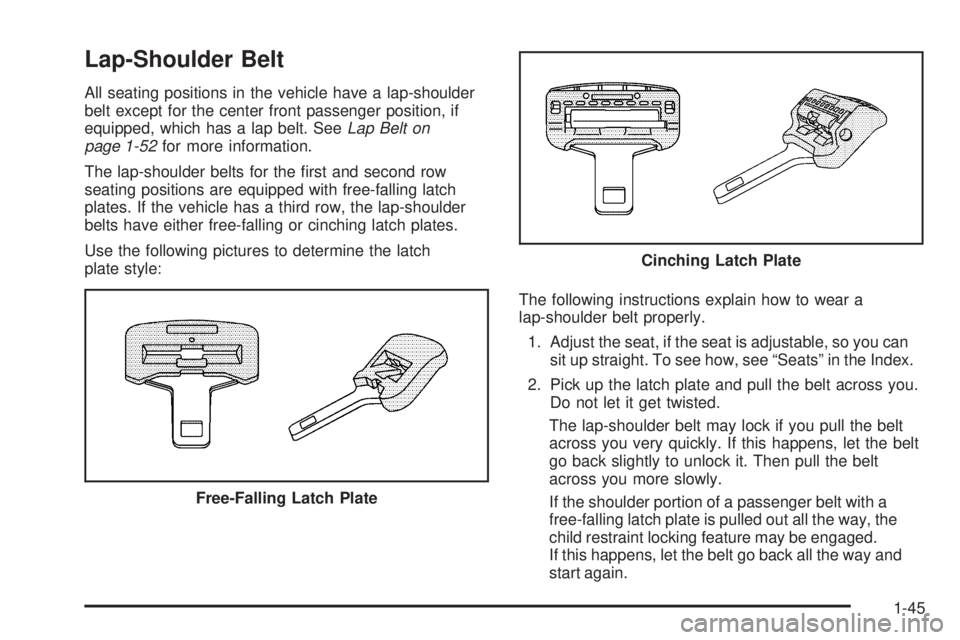
Lap-Shoulder Belt
All seating positions in the vehicle have a lap-shoulder
belt except for the center front passenger position, if
equipped, which has a lap belt. SeeLap Belt on
page 1-52for more information.
The lap-shoulder belts for the �rst and second row
seating positions are equipped with free-falling latch
plates. If the vehicle has a third row, the lap-shoulder
belts have either free-falling or cinching latch plates.
Use the following pictures to determine the latch
plate style:
The following instructions explain how to wear a
lap-shoulder belt properly.
1. Adjust the seat, if the seat is adjustable, so you can
sit up straight. To see how, see “Seats” in the Index.
2. Pick up the latch plate and pull the belt across you.
Do not let it get twisted.
The lap-shoulder belt may lock if you pull the belt
across you very quickly. If this happens, let the belt
go back slightly to unlock it. Then pull the belt
across you more slowly.
If the shoulder portion of a passenger belt with a
free-falling latch plate is pulled out all the way, the
child restraint locking feature may be engaged.
If this happens, let the belt go back all the way and
start again. Free-Falling Latch Plate
Cinching Latch Plate
1-45
Page 52 of 576
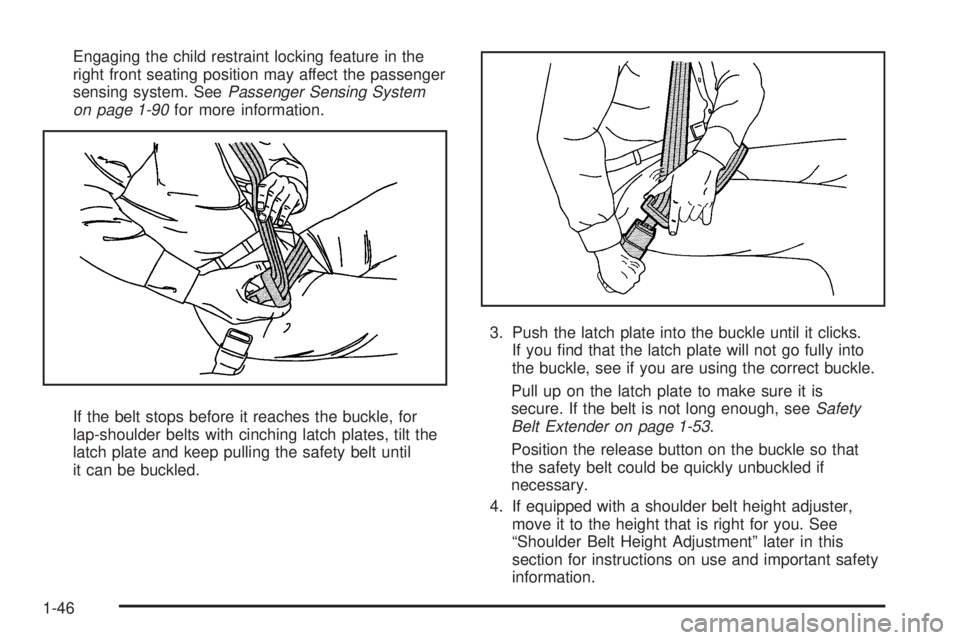
Engaging the child restraint locking feature in the
right front seating position may affect the passenger
sensing system. SeePassenger Sensing System
on page 1-90for more information.
If the belt stops before it reaches the buckle, for
lap-shoulder belts with cinching latch plates, tilt the
latch plate and keep pulling the safety belt until
it can be buckled.3. Push the latch plate into the buckle until it clicks.
If you �nd that the latch plate will not go fully into
the buckle, see if you are using the correct buckle.
Pull up on the latch plate to make sure it is
secure. If the belt is not long enough, seeSafety
Belt Extender on page 1-53.
Position the release button on the buckle so that
the safety belt could be quickly unbuckled if
necessary.
4. If equipped with a shoulder belt height adjuster,
move it to the height that is right for you. See
“Shoulder Belt Height Adjustment” later in this
section for instructions on use and important safety
information.
1-46
Page 54 of 576
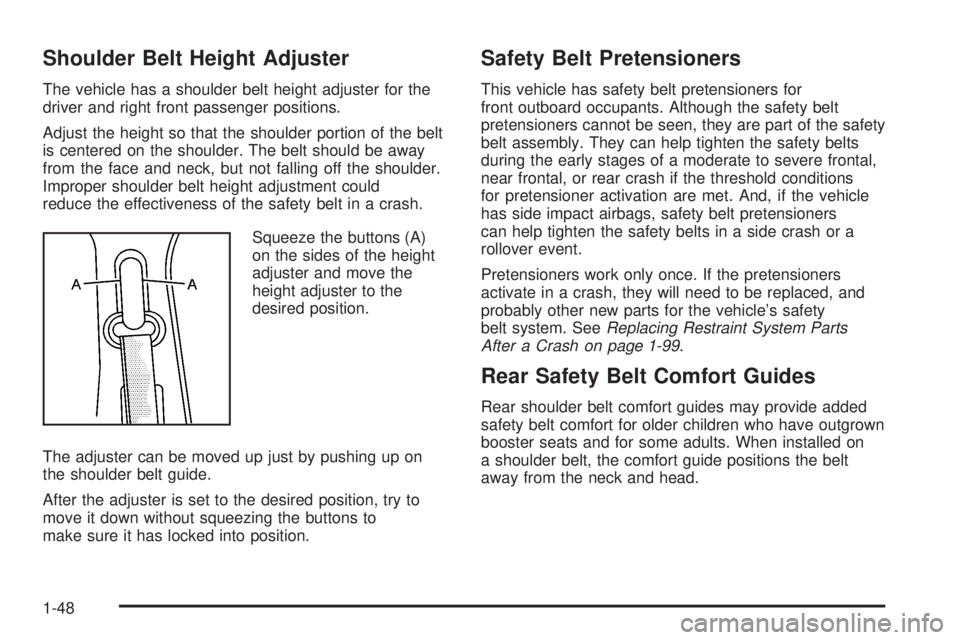
Shoulder Belt Height Adjuster
The vehicle has a shoulder belt height adjuster for the
driver and right front passenger positions.
Adjust the height so that the shoulder portion of the belt
is centered on the shoulder. The belt should be away
from the face and neck, but not falling off the shoulder.
Improper shoulder belt height adjustment could
reduce the effectiveness of the safety belt in a crash.
Squeeze the buttons (A)
on the sides of the height
adjuster and move the
height adjuster to the
desired position.
The adjuster can be moved up just by pushing up on
the shoulder belt guide.
After the adjuster is set to the desired position, try to
move it down without squeezing the buttons to
make sure it has locked into position.
Safety Belt Pretensioners
This vehicle has safety belt pretensioners for
front outboard occupants. Although the safety belt
pretensioners cannot be seen, they are part of the safety
belt assembly. They can help tighten the safety belts
during the early stages of a moderate to severe frontal,
near frontal, or rear crash if the threshold conditions
for pretensioner activation are met. And, if the vehicle
has side impact airbags, safety belt pretensioners
can help tighten the safety belts in a side crash or a
rollover event.
Pretensioners work only once. If the pretensioners
activate in a crash, they will need to be replaced, and
probably other new parts for the vehicle’s safety
belt system. SeeReplacing Restraint System Parts
After a Crash on page 1-99.
Rear Safety Belt Comfort Guides
Rear shoulder belt comfort guides may provide added
safety belt comfort for older children who have outgrown
booster seats and for some adults. When installed on
a shoulder belt, the comfort guide positions the belt
away from the neck and head.
1-48
Page 77 of 576
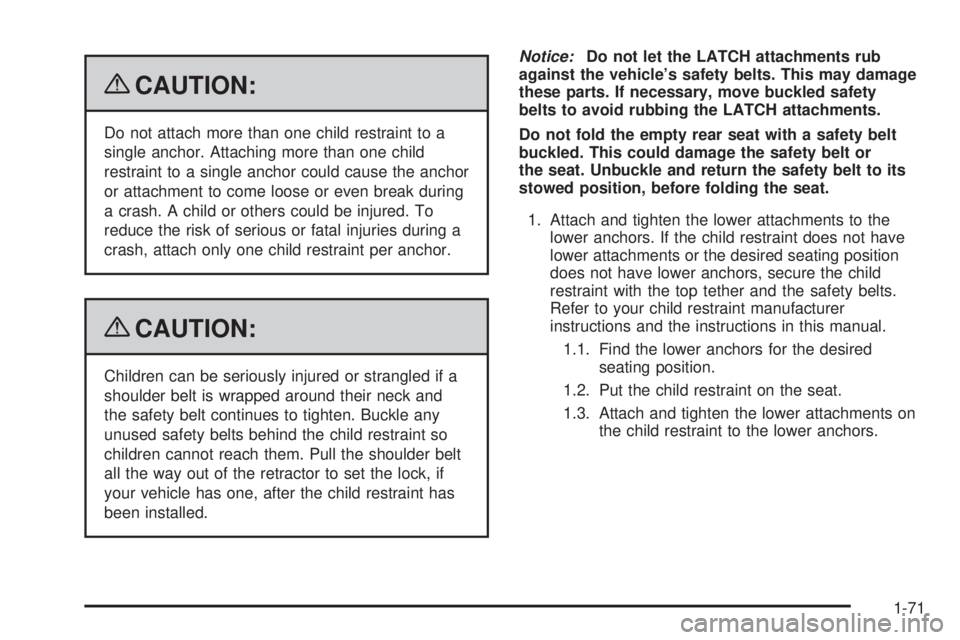
{CAUTION:
Do not attach more than one child restraint to a
single anchor. Attaching more than one child
restraint to a single anchor could cause the anchor
or attachment to come loose or even break during
a crash. A child or others could be injured. To
reduce the risk of serious or fatal injuries during a
crash, attach only one child restraint per anchor.
{CAUTION:
Children can be seriously injured or strangled if a
shoulder belt is wrapped around their neck and
the safety belt continues to tighten. Buckle any
unused safety belts behind the child restraint so
children cannot reach them. Pull the shoulder belt
all the way out of the retractor to set the lock, if
your vehicle has one, after the child restraint has
been installed.Notice:Do not let the LATCH attachments rub
against the vehicle’s safety belts. This may damage
these parts. If necessary, move buckled safety
belts to avoid rubbing the LATCH attachments.
Do not fold the empty rear seat with a safety belt
buckled. This could damage the safety belt or
the seat. Unbuckle and return the safety belt to its
stowed position, before folding the seat.
1. Attach and tighten the lower attachments to the
lower anchors. If the child restraint does not have
lower attachments or the desired seating position
does not have lower anchors, secure the child
restraint with the top tether and the safety belts.
Refer to your child restraint manufacturer
instructions and the instructions in this manual.
1.1. Find the lower anchors for the desired
seating position.
1.2. Put the child restraint on the seat.
1.3. Attach and tighten the lower attachments on
the child restraint to the lower anchors.
1-71
Page 82 of 576
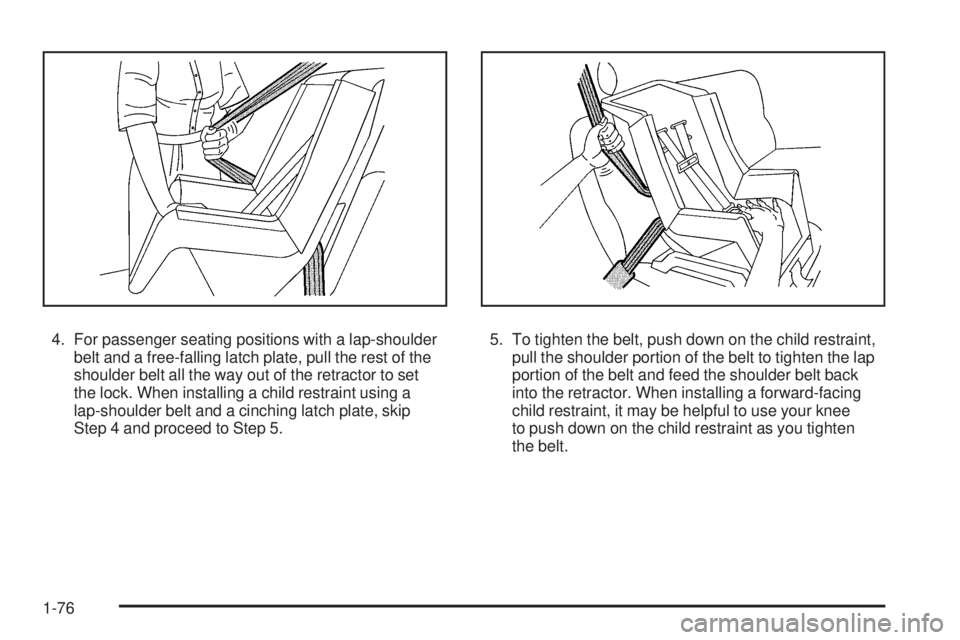
4. For passenger seating positions with a lap-shoulder
belt and a free-falling latch plate, pull the rest of the
shoulder belt all the way out of the retractor to set
the lock. When installing a child restraint using a
lap-shoulder belt and a cinching latch plate, skip
Step 4 and proceed to Step 5.5. To tighten the belt, push down on the child restraint,
pull the shoulder portion of the belt to tighten the lap
portion of the belt and feed the shoulder belt back
into the retractor. When installing a forward-facing
child restraint, it may be helpful to use your knee
to push down on the child restraint as you tighten
the belt.
1-76
Page 86 of 576

4. Push the latch plate into the buckle until it clicks.
Position the release button on the buckle so that
the safety belt could be quickly unbuckled if
necessary.5. Pull the rest of the shoulder belt all the way out of
the retractor to set the lock.
1-80
Page 91 of 576
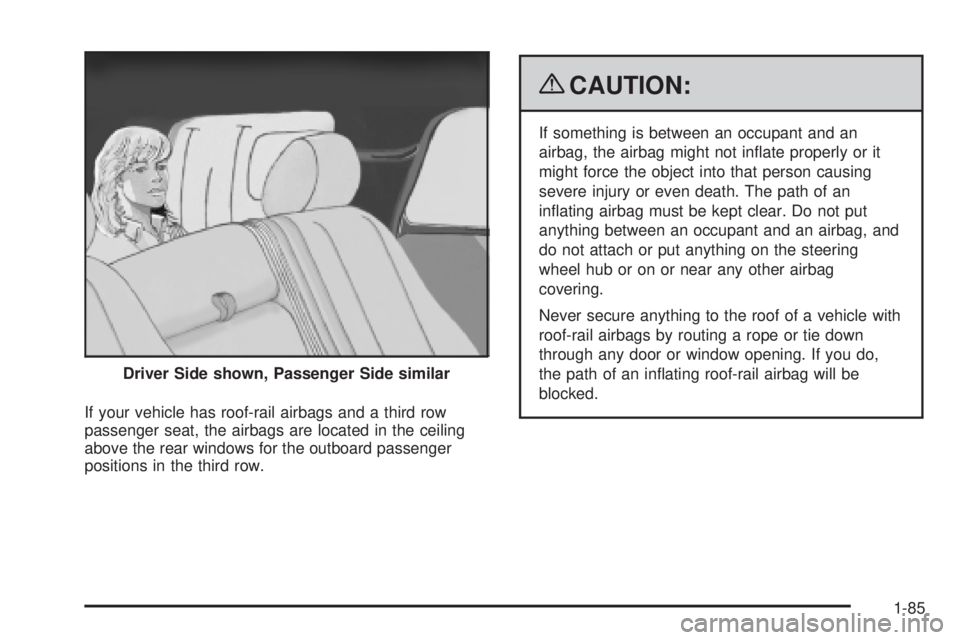
If your vehicle has roof-rail airbags and a third row
passenger seat, the airbags are located in the ceiling
above the rear windows for the outboard passenger
positions in the third row.
{CAUTION:
If something is between an occupant and an
airbag, the airbag might not in�ate properly or it
might force the object into that person causing
severe injury or even death. The path of an
in�ating airbag must be kept clear. Do not put
anything between an occupant and an airbag, and
do not attach or put anything on the steering
wheel hub or on or near any other airbag
covering.
Never secure anything to the roof of a vehicle with
roof-rail airbags by routing a rope or tie down
through any door or window opening. If you do,
the path of an in�ating roof-rail airbag will be
blocked. Driver Side shown, Passenger Side similar
1-85
Page 95 of 576
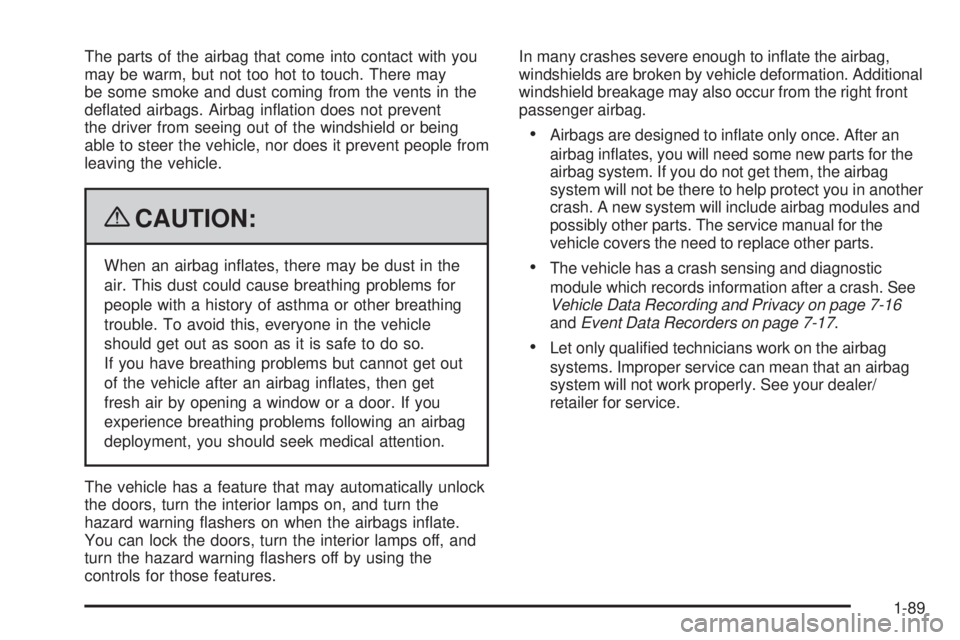
The parts of the airbag that come into contact with you
may be warm, but not too hot to touch. There may
be some smoke and dust coming from the vents in the
de�ated airbags. Airbag in�ation does not prevent
the driver from seeing out of the windshield or being
able to steer the vehicle, nor does it prevent people from
leaving the vehicle.
{CAUTION:
When an airbag in�ates, there may be dust in the
air. This dust could cause breathing problems for
people with a history of asthma or other breathing
trouble. To avoid this, everyone in the vehicle
should get out as soon as it is safe to do so.
If you have breathing problems but cannot get out
of the vehicle after an airbag in�ates, then get
fresh air by opening a window or a door. If you
experience breathing problems following an airbag
deployment, you should seek medical attention.
The vehicle has a feature that may automatically unlock
the doors, turn the interior lamps on, and turn the
hazard warning �ashers on when the airbags in�ate.
You can lock the doors, turn the interior lamps off, and
turn the hazard warning �ashers off by using the
controls for those features.In many crashes severe enough to in�ate the airbag,
windshields are broken by vehicle deformation. Additional
windshield breakage may also occur from the right front
passenger airbag.
Airbags are designed to in�ate only once. After an
airbag in�ates, you will need some new parts for the
airbag system. If you do not get them, the airbag
system will not be there to help protect you in another
crash. A new system will include airbag modules and
possibly other parts. The service manual for the
vehicle covers the need to replace other parts.
The vehicle has a crash sensing and diagnostic
module which records information after a crash. See
Vehicle Data Recording and Privacy on page 7-16
andEvent Data Recorders on page 7-17.
Let only quali�ed technicians work on the airbag
systems. Improper service can mean that an airbag
system will not work properly. See your dealer/
retailer for service.
1-89
Page 101 of 576
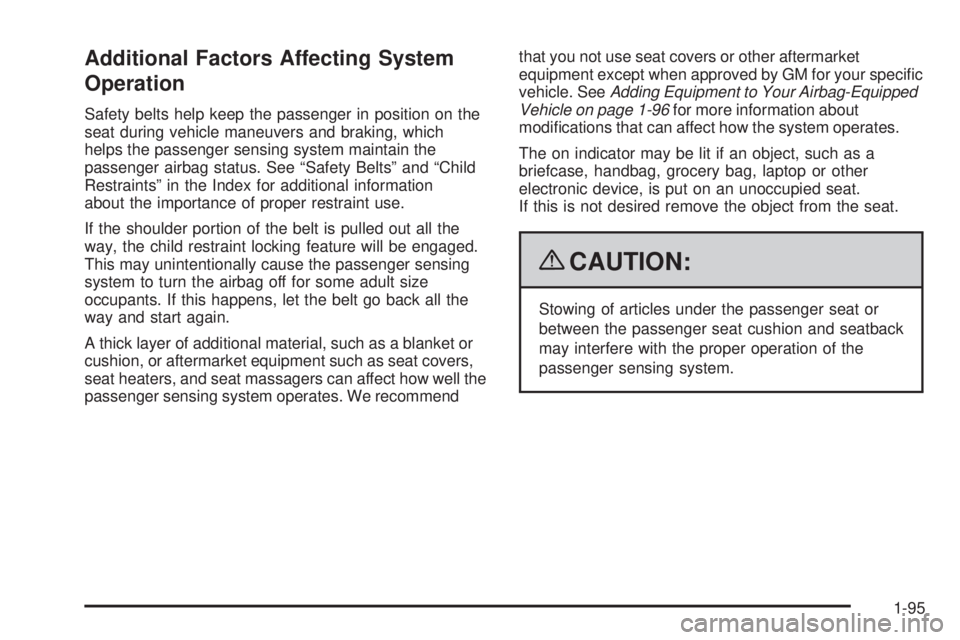
Additional Factors Affecting System
Operation
Safety belts help keep the passenger in position on the
seat during vehicle maneuvers and braking, which
helps the passenger sensing system maintain the
passenger airbag status. See “Safety Belts” and “Child
Restraints” in the Index for additional information
about the importance of proper restraint use.
If the shoulder portion of the belt is pulled out all the
way, the child restraint locking feature will be engaged.
This may unintentionally cause the passenger sensing
system to turn the airbag off for some adult size
occupants. If this happens, let the belt go back all the
way and start again.
A thick layer of additional material, such as a blanket or
cushion, or aftermarket equipment such as seat covers,
seat heaters, and seat massagers can affect how well the
passenger sensing system operates. We recommendthat you not use seat covers or other aftermarket
equipment except when approved by GM for your speci�c
vehicle. SeeAdding Equipment to Your Airbag-Equipped
Vehicle on page 1-96for more information about
modi�cations that can affect how the system operates.
The on indicator may be lit if an object, such as a
briefcase, handbag, grocery bag, laptop or other
electronic device, is put on an unoccupied seat.
If this is not desired remove the object from the seat.
{CAUTION:
Stowing of articles under the passenger seat or
between the passenger seat cushion and seatback
may interfere with the proper operation of the
passenger sensing system.
1-95
Page 107 of 576
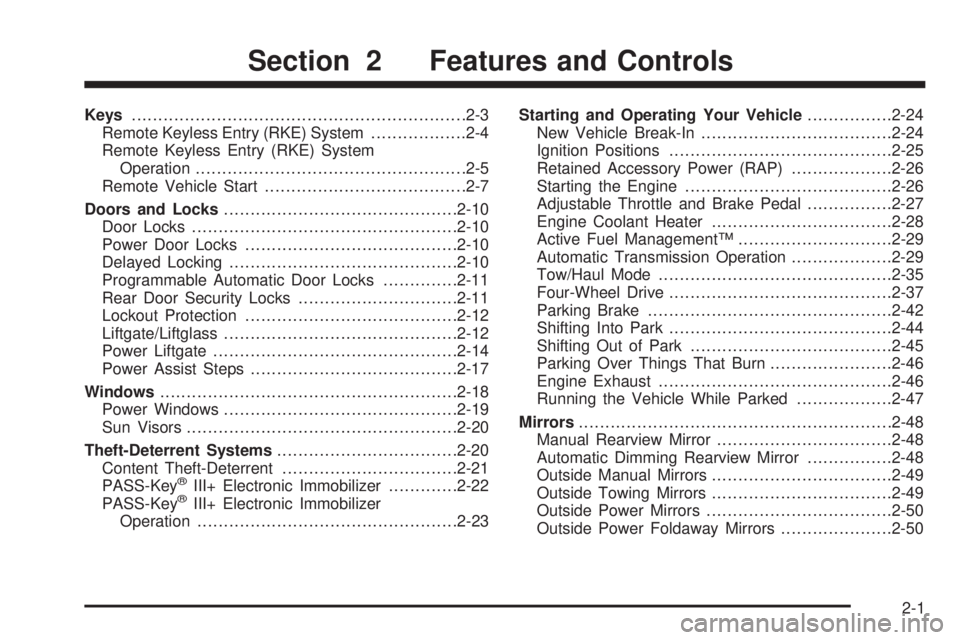
Keys...............................................................2-3
Remote Keyless Entry (RKE) System..................2-4
Remote Keyless Entry (RKE) System
Operation...................................................2-5
Remote Vehicle Start......................................2-7
Doors and Locks............................................2-10
Door Locks..................................................2-10
Power Door Locks........................................2-10
Delayed Locking...........................................2-10
Programmable Automatic Door Locks..............2-11
Rear Door Security Locks..............................2-11
Lockout Protection........................................2-12
Liftgate/Liftglass............................................2-12
Power Liftgate..............................................2-14
Power Assist Steps.......................................2-17
Windows........................................................2-18
Power Windows............................................2-19
Sun Visors...................................................2-20
Theft-Deterrent Systems..................................2-20
Content Theft-Deterrent.................................2-21
PASS-Key
®III+ Electronic Immobilizer.............2-22
PASS-Key®III+ Electronic Immobilizer
Operation.................................................2-23Starting and Operating Your Vehicle................2-24
New Vehicle Break-In....................................2-24
Ignition Positions..........................................2-25
Retained Accessory Power (RAP)...................2-26
Starting the Engine.......................................2-26
Adjustable Throttle and Brake Pedal................2-27
Engine Coolant Heater..................................2-28
Active Fuel Management™.............................2-29
Automatic Transmission Operation...................2-29
Tow/Haul Mode............................................2-35
Four-Wheel Drive..........................................2-37
Parking Brake..............................................2-42
Shifting Into Park..........................................2-44
Shifting Out of Park......................................2-45
Parking Over Things That Burn.......................2-46
Engine Exhaust............................................2-46
Running the Vehicle While Parked..................2-47
Mirrors...........................................................2-48
Manual Rearview Mirror.................................2-48
Automatic Dimming Rearview Mirror................2-48
Outside Manual Mirrors..................................2-49
Outside Towing Mirrors..................................2-49
Outside Power Mirrors...................................2-50
Outside Power Foldaway Mirrors.....................2-50
Section 2 Features and Controls
2-1